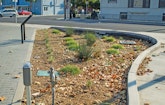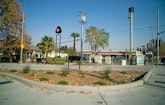
San Jose Environmental Services Director Kerrie Romanow has helped her department evolve into an environmentally sensitive stormwater management agency.
Interested in Stormwater?
Get Stormwater articles, news and videos right in your inbox! Sign up now.
Stormwater + Get AlertsSan Jose fits snugly in the center of California’s Santa Clara Valley, like an idyllic urban microchip. The so-called Capital of Silicon Valley is notably affluent and graced with a Mediterranean climate to the delight of its outdoorsy residents.
“We’re very fortunate to have 300 days of sunshine every year,” says Kerrie Romanow, director of the San Jose Environmental Services Department. “People spend a lot of time outdoors and are connected to the environment, so the (San Francisco) Bay and our creeks and streams are important to us. It’s really important to keep those waterways clean.”
The city receives just 16 to 18 inches of rainfall a year, which means that between rain events, pollutants build up on unwashed pavement, roofs, and other surfaces. “The concentration of pollution is higher when we do get those rains, so it’s even more important that we manage the runoff.”
Because its technology-powered economy makes the valley among the wealthiest urban areas in the U.S., the city and county jurisdictions have plentiful tax resources to draw upon in funding stormwater and sanitary sewer systems and solutions. Consequently, ‘green’ stormwater initiatives and prototype programs often spring up in San Jose or are adapted there and built out to a scale beyond the financial reach of many jurisdictions.
“I would say we are one of the leaders in green initiatives,” says Jeff Sinclair, the city’s Environmental Services supervisor. “San Jose is known throughout the Bay Area as a leader.”
Out of the gutter
One example is San Jose’s “green street” infrastructure projects, an idea actually imported from Portland, Oregon. In November, San Jose completed a second prototype of this stormwater runoff technique, targeting four intersections on Park Avenue. Asphalt was replaced with permeable pavement and curbside rain gardens. Each garden is a slightly sunken drainage area between street and sidewalk that runoff can enter through curb cuts.
In the decoratively planted garden, water is filtered through stones, mulch and a soil mix. In this way, the runoff is eased back into subsoil instead of accumulating on the surface and rushing into a stormwater gutter. An overflow drain in the garden handles pooled water when a particularly heavy rainfall overpowers natural drainage.
Some 6,500 square feet of rain gardens were constructed on the street and 2,800 square feet of permeable pavers laid. The two features work together, with the pavers reducing runoff to volumes that the gardens can absorb. In another neighborhood where pooling was common after rains, alleys were repaved so that their centers were lower than outer edges. Permeable pavers were laid in the center portion to allow rainfall to seep into underlying soil instead of accumulating on the surface. Some 36,000 square feet of alleyway was transformed.
Just the beginning
“We’re at the very beginning,” Romanow says. “We needed to do a couple of preliminary projects to see what would work here, but we’ll continue to expand our green street program.”
Three of the pilot programs were funded from California State Water Resources Control Board grants totaling $4 million, with the San Jose Department of Public Works providing design and engineering help. Romanow’s department administers the grant money and monitors completed projects to determine their effectiveness.
“We are still learning a lot. We are learning what is easier to maintain and what ones are more challenging,” she says. “We want to know what really works and what is really expensive to maintain. It is one thing to say we are allowing nature to work, but if crews have to go out there and spend a lot of time maintaining the gardens, it’s not realistic.”
There isn’t a rigid set of criteria for selecting which San Jose roadways get green street treatment, but there are several considerations. “Oftentimes the width of a street is a limiting factor,” Sinclair says. “Parking can be a limiting factor. Underground and above-ground structures can be a factor.”
Sharon Newton, San Jose’s water testing program manager, says that coordinating the work with other departments is also a factor in choosing project locations. “One of the things we look at specifically in determining sites is the opportunity to collaborate with the public safety department. We always look to see where they are working on traffic improvement projects. There are benefits in combining construction projects.”
Gaining support
Besides the obvious reasons for introducing the pilot projects where they did — the streets were beautified and made safer by eliminating pooling runoff water — the department also weighed the public relations value of a site, according to Romanow. That is, the department considered locations where excess water in streets and alleys was a long-standing aggravation. The locations were prime candidates for the initiatives because the department knew the work would be appreciated by neighborhood residents.
“In those areas, residents will notice the difference and appreciate the value of the projects, as well as the engineering that went into them,” she says. “They can see that it is transformational and truly benefits the environment.”
These testimonies help build public support for future environment-friendly solutions. Romanow says the department enjoys widespread support, “but I’m not sure all the community understands how these solutions work. The concepts of green streets and green infrastructure are still new, so San Jose independently and in collaboration with Bay Area stormwater partners continues to conduct outreach and education efforts.”
The city’s Environmental Services Department has an operating budget this fiscal year of $312.5 million, which is swelled by $1.4 billion 10-year funding from a San Jose-Santa Clara Regional Wastewater Facility Capital Improvement Program. Romanow says the department doesn’t designate a specific percentage of the budget for so-called green initiatives.
“We actually don’t track things that way,” she says. “Environmental initiatives are just what we do and should not be isolated. They are not tracked separately. We look at what will help in the long term. If there is a project that’s projected to cost $500,000 and 10 percent more will make it a green project, just as a matter of course, we will do that.”
Environmental evolution
Not all San Jose stormwater falls within the purview of the Environmental Services Department. Some solutions still rely on old-fashioned regulations and traditional infrastructure. While the city has no heavy manufacturing, industrial centers that do operate within the city are monitored by a separate municipal storm sewer capital improvement and inspection regime. The city has 2,000 stormwater treatment units at 300 locations around the city, 28 stormwater pumping stations, and almost 1,200 miles of storm sewer mains.
Romanow says the 540-person Environmental Services Department really began to hit its stride as an environmentally sensitive stormwater management agency about a decade ago. That happens to correspond to when she arrived and the department began developing a sustainable plan. She became director seven years ago.
Newton is a 27-year veteran of the department and has witnessed its evolution. “Our understanding has grown year by year. We want to learn more every year — want to try new things, and do new things, and be among the first in doing things. We try to think of ways to protect the environment and the natural resources we have.”
She says this openness to innovation tends to build upon itself. “With each stormwater permit, we add a list of things to accomplish, and then we start thinking about the next project. In the course of looking at how to expand protection efforts, we ask ourselves: ‘Is it possible to do this or do that?’ We try to incorporate all these new things as we move ahead.”
New projects aren’t always an overwhelming success, but Romanow says the department has never experienced a failed initiative. “Some things that we tried worked, but we decided not to expand them. We found we could tweak some things and make them work better, but chose not to do so.”
Renewed interest
The Guadalupe River meanders north past downtown San Jose to the Bay 9 miles away. Coyote Creek ambles by on the other side of the city. Many of the management decisions made by Romanow and her staff target these two bodies of water. The city doesn’t have reservoirs so protecting such bodies of water is not a San Jose management concern. That falls under the auspices of the Santa Clara Valley Water District.
Burgeoning economies like San Jose’s mean lots of construction projects, housing developments, commercial structures, and repurposing of existing retail buildings. The primary concern of the Environmental Services Department with such developments is management of pollutant discharges and runoff. The city weighs the stormwater impact of proposed developments during a project review process and requires low-impact designs.
Droughts in the valley have yielded for now to more regular rains. Romanow says this has spurred new interest in stormwater management and, specifically, in green responses. “In our experience, residents have been receptive to the concept of green infrastructure,” she says. That receptivity is expected to grow as more green projects are successfully implemented.










